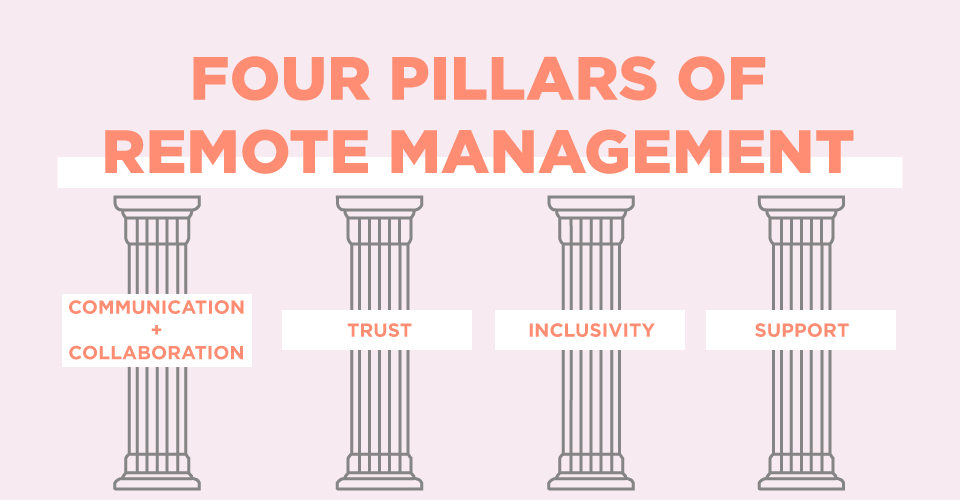Whether you work in an office but part of your team is remote, you’re remote and manage a team of both office and remote workers, you’re taking your in-office team remote or building a remote team from scratch, there are both huge advantages and unique challenges to managing a remote team.
Pardon our interruption—this is Career Contessa. Join us for this episode of
The Femails where we talk about all things work from home and the
coronavirus.
The advantages include increased productivity, increased happiness, and decreased spending (both employer and employee). The challenges include ditching the idea of measuring work by time spent in the office.
With Logitech, we are examining what it takes to successfully manage a remote team.
Let’s dive in.
Ditch Your Micromanaging Ways
Even a seasoned manager might have some micromanaging ways. When you’re accustomed to being able to stroll over to your employees’ desks to discuss strategies, goals, and future projects, letting go can be tough.
As a remote manager, micromanaging is going to be tough to impossible. Consider it a blessing. Micromanaging has huge setbacks for any manager—and their entire team. In
a report by Trinity Solutions published in Harry E. Chambers’ book
My Way or the Highway, 85 percent of employees who were being micromanaged reported that their morale was impacted negatively by it.
So, ditch your micromanaging ways. This guide to remote management will explore how to replace micromanaging with communication, trust, inclusivity, and support for your remote workers. If this sounds a little “woo woo” to you, we hear you. But these four pillars are great motivators and employee retention tools.
To create a healthy, ongoing relationship with your remote employees, implement the four pillars of remote management success.
- Communication and Collaboration
- Trust
- Inclusivity
- Support
Communication and collaboration are the most important elements of any healthy workplace—whether or not it’s remote.
According to
Tim Hagen of Progress Coaching, lack of communication is the enemy of remote work. Hagen explains, “If we do not schedule time or talk with one another and hopefully face to face, silence becomes very loud and dangerous, as remote employees might end up wondering how they’re doing.”
Communicate regularly. This can be as simple as saying “good morning” at the top of the day. If you will be away from your computer for an extended period of time, communicate that to your employees. Offer guidance or resources when a project is going over deadline.
What you’ll want to avoid, as a remote manager, is only communicating with your employees when you encounter a problem. Create an open environment wherein you can communicate with your employees regularly.
Another way to communicate efficiently is by centralizing data, information, and team progress, whenever possible.
Cloud-based collaboration
One of the first steps you’ll need to take as a remote manager is in making everything available to everyone on the team. This doesn’t mean publishing your entire team’s payroll in a Google Doc for all to see.
Use cloud-based applications to collaborate on documents that your team needs to access. Here are a few things to consider having in shared cloud storage for everyone to access:
- Employee handbook (which, of course, will detail all remote process and expectations in one document)
- Company logo files
- Historical marketing data
- Editorial calendars
- Project progress + activity
By storing important files and documents in centralized storage, your employees can access information and collaborate at any time from any device.
To set and monitor expectations, consider implementing project management software, open communication channels like Gchat and Microsoft Teams, and fillable document templates for your employees to complete and present on a weekly basis.
Trust is going to be the cornerstone of any remote employee/employer relationship. Both parties need to have faith and trust that the other is pulling their weight.
When hiring a new employee to work remotely, trust will be a huge part of the interview process. Especially when the interview process is being conducted over video or phone, a manager will need to structure interview questions around softer skills like reliability, trust, dependability, and accountability.
When working with a team that includes a mix of remote and office workers, a manager and employee might already have an existing trust system. If you’re going remote for the first time or adding a new remote worker to the team, you will need to build processes and set expectations to maintain a healthy, trust-filled relationship.
To Build Trust, Set Expectations
Expectations must be set from the beginning. Since you, the manager, will have a lot less insight into how work is getting done, you’ll need to be explicit and clear about your expectations from the get-go.
For example, if you expect an employee to keep a set number of hours within a certain time zone, communicate that. If you are less concerned about what hours are spent and you’re more concerned with work completed, communicate that, too.
Focus on Goals, Not Activity
Another way to create and foster a workplace built on trust is to shift traditional thinking around a crucial aspect of management. In this case work from anywhere can also mean work at any time.
It’s time to do away with the old “eight hours at the desk” rule and focus instead on goals—specifically on tracking and achieving goals. According to
a study by Stanford University, remote workers, free of long commutes, worked a true full-shift more often than they had while commuting.
With remote workers feeling more productive, especially when they are empowered to work during their more productive windows—whether it’s very early morning or late night—it becomes unnecessary to police time spent “at work.”
Once you go remote, there are naturally employees you will interact with more than others. To build an inclusive workforce, create opportunities to interact with all of your employees.
It’s important to create and maintain an inclusive environment for all employees. Make sure that your remote employees feel empowered and included by being responsive and communicative. Connecting via video is a great way to secure regular facetime.
Face Time Is Crucial
This can include a monthly or weekly “All Hands Meeting” with the entire team, in addition to weekly 1:1s with employees who directly report to you, periodic departmental meetings, and ad-hoc huddles just like you might have in the office.
A weekly 1:1 is crucial for employer-to-employee communication. Unlike an all hands or a departmental meeting, a 1:1 is dedicated time for a manager to speak directly to their employee. A remote 1:1 meeting can be structured to check in with your employee personally, professionally, and to check in on how processes are working for the employee overall. 1:1s offer a great opportunity for an employee to gain a direct exclusive line to their manager.
While you don’t want to hold a meeting for the sake of having a meeting, face time is important when operating remotely. Structure meetings so that your team or employee has time to communicate wins, challenges, works in progress, and plans for going forward.
Video collaboration tools make it easy for coworkers to interact face-to-face, build and maintain rapport, and read facial expressions, tone, and inflection. While email and messaging are great, video allows a face-to-face collaboration that is as close to “the real thing” as possible.
Just like communication, trust, and inclusivity, constant support is a cornerstone of any work relationship. But what does support mean? Does it mean consistently checking in with employees? Does it mean making sure processes in place are working for everyone? Does it mean making sure your employees aren’t suffering from a learning stall out from operating remotely?
In short, yes. Good, proactive support means keeping all of these aspects of an employee’s continued success in mind. Here are a few ways to do that.
Create Learning Opportunities + Coaching
Whether your employees are operating remotely or sitting a few desks down from you, continued learning is crucial to any workplace.
Create opportunities for your remote workers to continue their learning. A common drawback to remote work can be the lack of interaction with others. You never know how much you learned in offhand conversations with your office mates until you're no longer together.
Offer learning opportunities often. Some great ways you can offer and encourage your employees to continue learning are:
- By allotting an education stipend
- By encouraging and facilitating in-house, cross-departmental mentorship
- By offering to pay for local conferences
- By meeting up, as a team, for a conference
With these new managerial guidelines in place, your remote team is bound for remote success—and they can feel super empowered to #WorkFromAnywhere.
This post is sponsored by Logitech in honor of its ongoing support for remote work and telecommuting. To learn more about Logitech’s work from anywhere initiative, click here. For additional insight on workplace trends in the age of collaboration, download Logitech’s Workplace Trends in 2020 and Beyond ebook here.
















